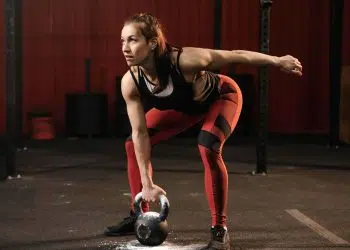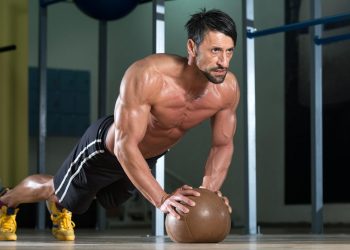Despite its widespread use and popularity, the kettlebell swing is one of the exercises most likely to be done incorrectly. Many well-known fitness experts have been seen murdering kettlebell swings, risking long-term spine health in the process.
That’s a real shame because done right, the kettlebell swing is a very powerful exercise with a long list of benefits. In fact, whatever your training goal is, swings will help you get there faster.
The swing is:
- A great metabolic conditioning exercise
- Fantastic for fat loss and body recomposition
- A useful alternative to the more complex Olympic lifts
- An almost unbeatable posterior chain exercise
In this article, we reveal how to do kettlebell swings correctly and provide you with a few variations and alternatives that you can use to keep your training productive and interesting.
Related: Dumbbells vs. Kettlebells – Which One Should You Use?
Kettlebell Swings – Muscles Worked
Kettlebell swings are a compound exercise that involves your upper and lower body. As such, it involves several important muscles. The main muscles engaged during kettlebell swings are:
Level Up Your Fitness: Join our 💪 strong community in Fitness Volt Newsletter. Get daily inspiration, expert-backed workouts, nutrition tips, the latest in strength sports, and the support you need to reach your goals. Subscribe for free!
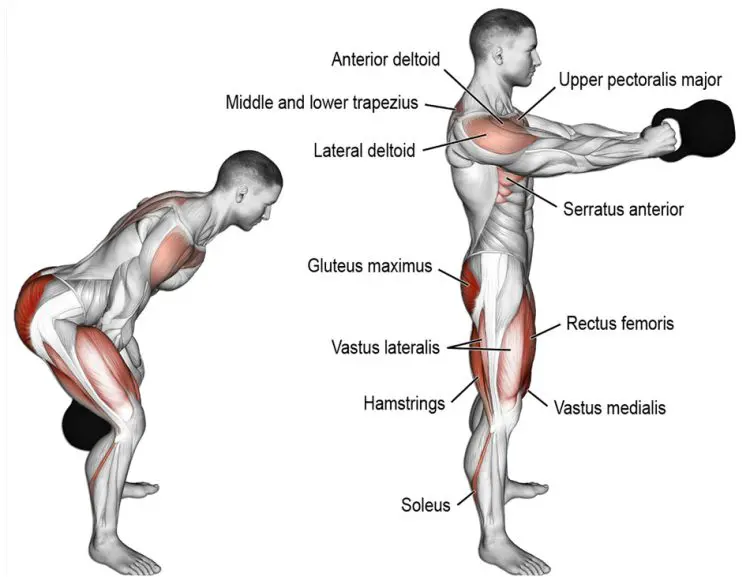
Gluteus maximus
Known as the glutes for short and basically your butt, the gluteus maximus is the large muscle driving the powerful hip extension of kettlebell swings. Increase glute activation by contracting your butt as hard as you can at the top of each rep.
Hamstrings
Working with your glutes, your hamstrings also extend your hips. There are three muscles in the hamstring group; biceps femoris, semimembranosus, and semitendinosus. The hamstrings also flex your knees, i.e., when you do leg curls.
Quadriceps
While kettlebell swings are mostly a hip hinge exercise, that doesn’t mean your posterior chain does all the work. Your quadriceps, or quads for short, are also involved in swings, albeit in a relatively minor role. The quadriceps extend your knee. This group has four muscles: rectus femoris, vastus lateralis, vastus medialis, and vastus intermedius.
Core
Core is the term used to describe the muscles that make up your midsection, including rectus abdominis, obliques, transverse abdominis, and erector spinae. These muscles work together to stabilize your spine and prevent your lower back rounding. A strong core ensures that you can efficiently generate force with your lower body and transfer it to the kettlebell.
Trapezius and rhomboids
Located across and between your scapulae, the traps and rhomboids retract, depress, and elevate your shoulder blades. During kettlebell swings, the traps and rhomboids stabilize your shoulders, holding them down and back.
Latissimus dorsi
Known as your lats for short, this muscle is located on the aide of your upper back. Lat engagement depends on how forcefully you swing the weight downward.
Deltoids
While most of the power in kettlebell swings comes from your lower body, your upper body gets in on the act too. You can increase the power of your swing by using your deltoids or shoulder muscles more. Your delts are also involved in decelerating the kettlebell at the bottom of each swing.
Forearms
Kettlebells often have fat handles which makes them harder to grip. A high rep set of kettlebell swings will test and develop your forearms. Use chalk to stop your hands from slipping and enhance your grip.
How to Do Kettlebell Swings
Get the most from kettlebell swings while keeping your risk of injury to a minimum by following these guidelines:
- Hold your kettlebell in front of your hips using an overhand grip. Stand with your feet about shoulder-width apart, toes turned slightly outward. Brace your core and pull your shoulders down and back.
- Bend your knees slightly, hinge forward from your hips, push your butt back, and lower the kettlebell down between your knees. Do NOT round your lower back.
- Drive your hips forward as if you were doing a standing long jump. Use this momentum to swing the kettlebell forward and up to shoulder level. Keep your arms straight.
- Using your abs and lats, swing the kettlebell back down and hinge at your hips again.
- Transition immediately into another rep.
You can also start a set of kettlebell swings with the weight resting on the floor in front of your feet. Take hold of the handle, brace your abs, and then “hike” it back between your legs like a football. Try both methods to see which one works best for you.
Note: Most CrossFitters do overhead kettlebell swings, also known as American swings. While this is an accepted and common way to swing a kettlebell, it could lead to hyperextension of the lumbar spine. This variation also requires excellent shoulder mobility.
In contrast, swinging the weight up to shoulder height, AKA a Russian swing, is a little more lower back-friendly, requires less shoulder mobility, and may allow you to use heavier weights.
Experiment to see which one you prefer. Alternatively, split the difference and swing your kettlebell up until your arms are at about 60-70 degrees.
Russian swing:
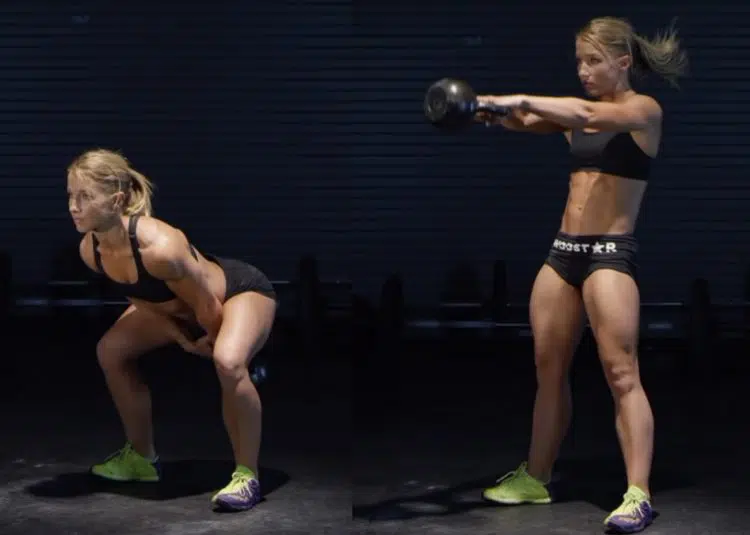
American swing:
Kettlebell Swings Benefits and Drawbacks
Not sure if kettlebells deserve a place in your workouts? Check out this list of benefits:
Blast your posterior chain
A lot of lifters spend too much time training the muscles they can see in the mirror. Kettlebell swings work the muscles on the back of your body: the posterior chain. These muscles are essential for better posture, increased athleticism, and just sculpting a better butt!
Easier to learn than the Olympic lifts
Done explosively with heavy weights, the kettlebell swing is an excellent power exercise that’s comparable to cleans and snatches. However, unlike those lifts, it’s a LOT easier to learn. So, if you want to increase muscle power but don’t have the time or patience to learn the Olympic lifts, do kettlebell swings instead.
An excellent conditioning exercise
While you can build power with heavy kettlebell swings, you can also use this exercise to improve your fitness and burn calories and fat. Using a moderate weight, a high rep set of kettlebell swings will challenge your cardiovascular system.
Level Up Your Fitness: Join our 💪 strong community in Fitness Volt Newsletter. Get daily inspiration, expert-backed workouts, nutrition tips, the latest in strength sports, and the support you need to reach your goals. Subscribe for free!
Try doing 15-20 reps of every minute on the minute (EMOM) for ten minutes to experience the conditioning effect of kettlebell swings for yourself.
A full-body exercise
There aren’t too many muscle groups that AREN’T involved in kettlebell swings. If you only have time to do one exercise, kettlebell swings make an excellent choice. Add some push-ups to train your entire body in just two exercises.
Reinforce your hip hinge
Squats, deadlifts, Romanian deadlifts, and bent-over rows involve a movement called a hip hinge. A hip hinge involves bending forward without rounding your lower back. Kettlebell swings involve the same movement, making them an ideal exercise for reinforcing your hip hinge. Mastering the hip hinge will have a beneficial effect on your performance of many other exercises.
Grip it and rip it
Kettlebell swings, like deadlifts, are a very satisfying exercise to perform. Once you know how to do them, you’ll be able to just grab a kettlebell and swing it powerfully without too much thought. If you want to work off some stress, kettlebell swings are one way to do it.
While kettlebell swings are a mostly beneficial exercise, there are also a few drawbacks to consider:
Rounding your lower back
The most significant risk of injury during kettlebell swings is rounding your lower back. The transition from lowering to lifting is a real “danger zone,” and a lack of core strength and poor positional awareness could result in loss of neutral spine. Ways to avoid this include not going too heavy too soon, learning to brace your core statically before trying swings, and not hiring Jillian Michaels as your trainer!
7 Kettlebell Swing Variations and Alternatives
While kettlebell swings are undoubtedly an excellent exercise, there are several variations and alternatives you can use to avoid boredom and keep your workouts interesting and productive:
1. Single-arm kettlebell swing
If you’ve mastered the two-handed swing, try the single-arm variation. Using just one kettlebell means you’ll need to engage your obliques to prevent rotation. You will also have to work harder to keep your shoulder pulled down and back. This is a useful option if you only have a light kettlebell to train with.
How to do it:
- Hold a kettlebell in front of your hips with one hand. Stand with your feet about shoulder-width apart. Pull your shoulders down and back and brace your core.
- Bend your knees slightly, hinge forward from your hips, push your butt back, and lower the kettlebell down between your knees. Do NOT round your lower back or turn your shoulders or hips.
- Drive your hips forward and use this momentum to swing the kettlebell forward and up to shoulder level. Keep your arm straight and your hips and shoulders square.
- Swing the kettlebell back down and transition immediately into another rep.
You can do a set with one arm and then switch sides, or if you like a challenge, swap hands rep by rep.
2. Kettlebell swing and row
Combine kettlebell swings with a rowing action to increase upper body muscle activation and give your back a good workout. You should also find that the additional movement increases your heart and breathing rate even more than regular swings.
How to do it:
- Set up kettlebell swings as usual. Hinge forward from your hips and lower the weight between your knees. Do not round your lower back. Drive your hips forward and swing the weight up to shoulder height.
- At the apex of your swing, bend your arms and row the kettlebell in toward your chest, and then quickly press it back out again.
- Lower the weight and repeat.
This exercise can be done two-handed, using one arm, or also using two kettlebells.
3. Double kettlebell swing
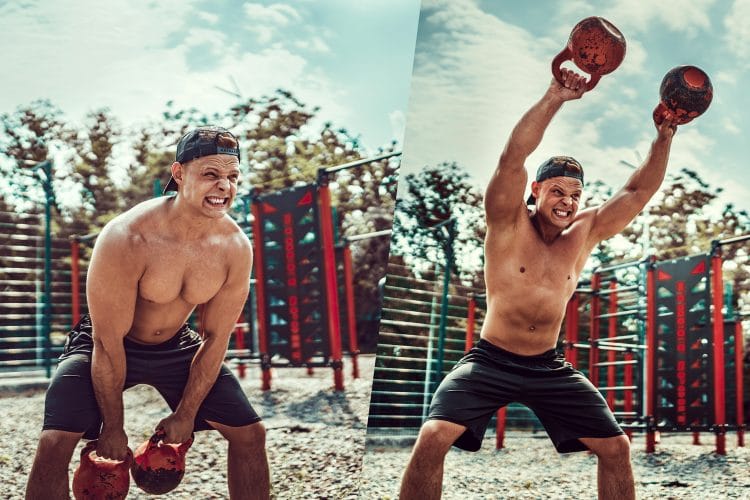
Swinging two kettlebells simultaneously means having to control two independent loads, increasing the balance, coordination, and stability demand of this already challenging exercise. Also, depending on the size of your kettlebells, you may need to adopt a wider stance.
The double kettlebell swing is a useful way to make swings harder when you don’t have a heavy kettlebell and only have access to two medium or light weights. You can also use mismatched kettlebells, e.g., 12kg and 16kg, to create an unbalanced load that further increases instability.
Perform your swings as usual while paying extra attention to bracing your core and keeping your shoulders and hips square.
4. Sumo deadlift high pull
No kettlebells? While you can do swings with a dumbbell, the close grip is quite awkward. A better option for most exercisers is sumo deadlift high pulls. This exercise works all of the same muscles as kettlebell swings, but all you need is a barbell.
How to do it:
- Place a barbell on the floor. Grasp it near the middle with an overhand grip. Your hands should be about 12 to 18 inches apart. Stand with your feet wider than shoulder-width apart, toes turned slightly outward. Drop your hips, lift your chest, brace your core, and pull your shoulders down and back.
- Stand up explosively and, as the bar passes your knees, pull strongly with your arms and draw the bar up the front of your body to just below your chin. Your elbows should be above your hands.
- Extend your arms, lower the weight back to the floor, and repeat.
- You could also do this exercise with a kettlebell.
Read also: 5 Awesome Benefits Of Sumo Deadlift High Pulls
5. Overhead medicine ball throw
The overhead medicine ball throw looks and feels a lot like a kettlebell swing. The only real difference is that, as the weight reaches its apex, you release it. This means the overhead medicine ball throw is potentially a better power exercise, as there is no need to try and decelerate the load at the terminal point of the movement. However, you will need more space to do this exercise.
How to do it:
- Stand with your feet shoulder-width apart and hold a medicine ball in front of your hips. Brace your core, and pull your shoulders down and back.
- Hinge forward from your hips and lower the ball between your knees. Do not round your lower back.
- Without bending your arms, stand up explosively and throw the ball up, overhead, and behind you. Do not throw it straight up; that’s an accident waiting to happen.
- Retrieve the ball and then repeat.
6. Medicine ball slams

Medicine ball slams involve the opposite movement pattern to kettlebell swings, which is what makes them such a valuable alternative. Do slams to ensure you develop both sides of your body equally. Like kettlebell swings, medicine ball slams are a great conditioning exercise and useful for developing explosive power.
How to do it:
- Hold a medicine ball in your hands and stand with your feet about shoulder-width apart. Brace your core.
- Raise the medicine ball above your head and come up onto your toes. You can also keep your feet flat if you wish.
- Putting your whole body into the movement, hurl the ball down at the floor just in front of your feet.
- Retrieve the ball as it bounces and repeat.
- Do not use a gel-filled ball for this exercise as they are prone to splitting. Instead, use a slam ball, heavy-duty rubber medicine ball, or an old-fashioned leather medicine ball.
7. Thrusters
Thrusters don’t look a whole lot like kettlebell swings, but they are another full-body strength and conditioning exercise that provides a huge amount of bang for your workout buck. Like kettlebell swings, thrusters are a CrossFit staple and a really challenging but productive movement.
How to do it:
- Hold a barbell across the front of your shoulders with an overhand shoulder-width grip. Stand with your feet about shoulder-width apart. Brace your core.
- Squat down until your thighs are roughly parallel to the floor.
- Rapidly stand up and use this momentum to help you press the bar up and overhead.
- Lower the bar back to your shoulders and repeat.
- You can also do this exercise with dumbbells, kettlebells, a medicine ball, or a sandbag.
Related: Thrusters – Muscles Worked, How-To, Benefits, and Alternatives
Kettlebell Swings – Wrapping Up
The kettlebell swing is one of the most versatile exercises you can do. By adjusting the weight and your rep range, you can use swings to train for almost any conceivable goal, from burning fat to getting fit to building the rear of the year.
That said, the swing is also an easy exercise to get wrong. Involving a rapid hip hinge and a large range of motion, you really need to know what you are doing. Poor form could lead to serious injury.
So, start light, brace your core, monitor your lumbar spine, and practice! That way, you can enjoy all of the benefits of kettlebell swings with none of the risks.
Interested in measuring your progress? Check out our strength standards for Push Ups, Clean, Snatch, and more.



